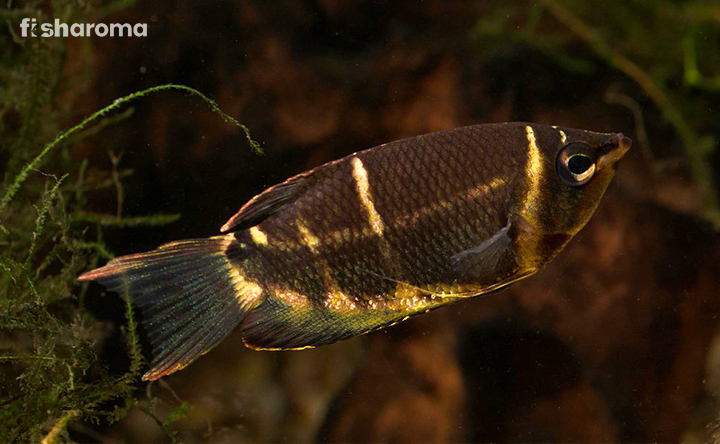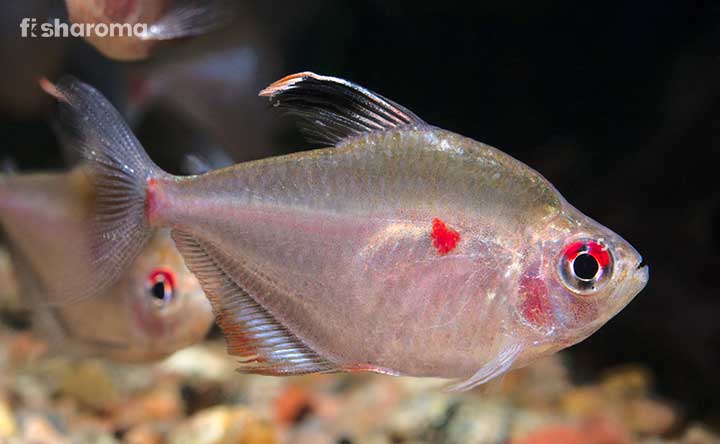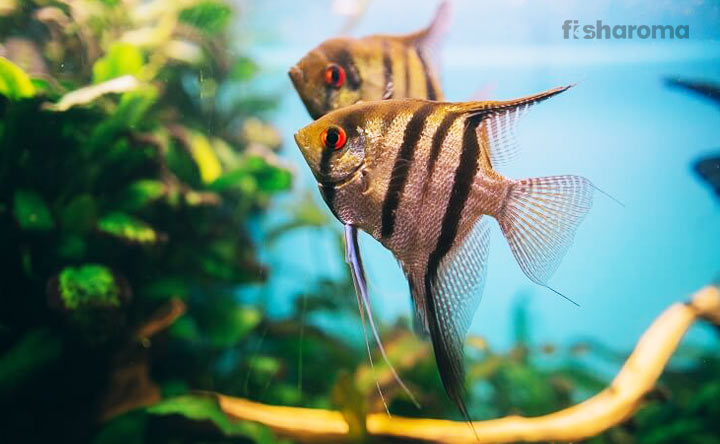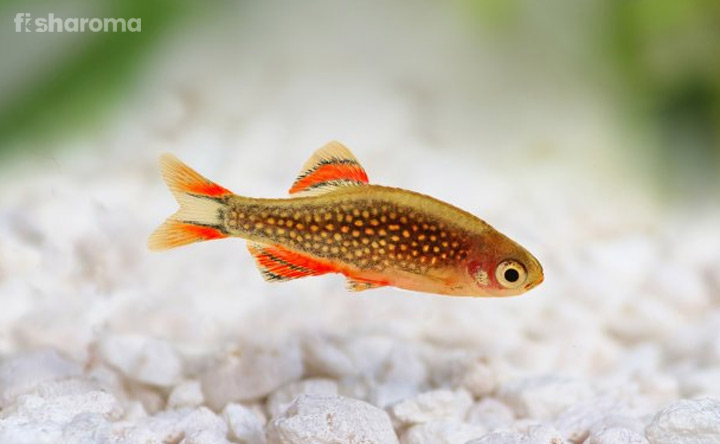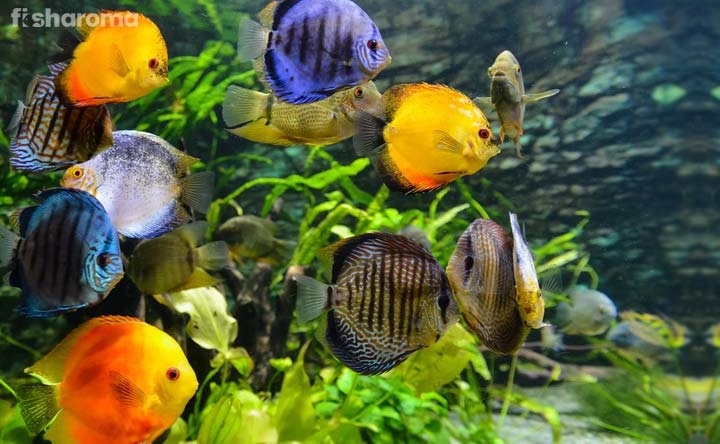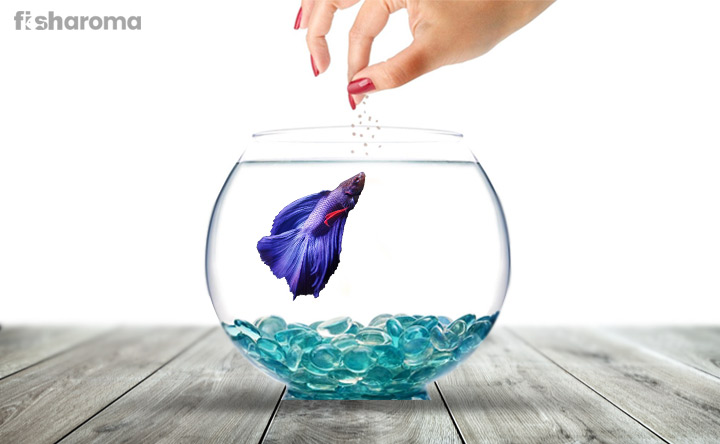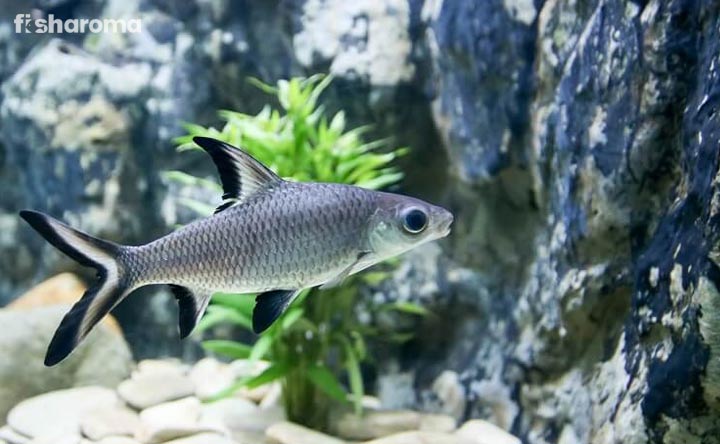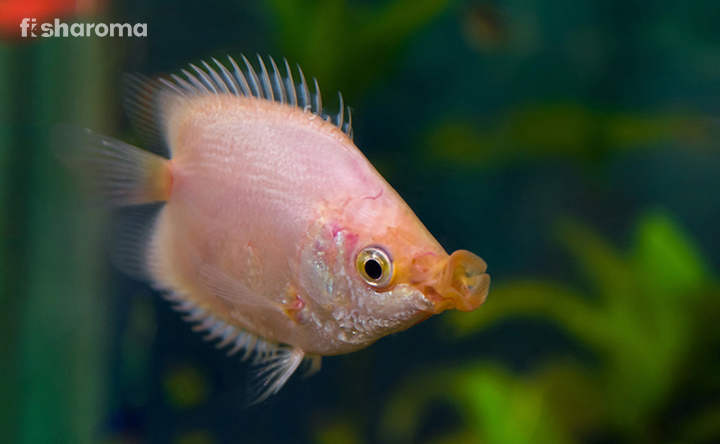Moonlight Gourami: A Thorough Care Guide of This Lunar Beauty

- Origin & Habitat of Moonlight Gourami
- Appearance of Moonlight Gourami
- Behaviour of Moonlight Gourami
- Lifespan of Moonlight Gourami
- Diet of Moonlight Gourami
- Tank Requirements for Moonlight Gourami
- Water Types for Moonlight Gourami
- Compatibility of Moonlight Gourami
- Breeding of Moonlight Gourami
- Diseases and Treatment of Moonlight Gourami
- Summary
It is extremely natural for any aquarist to make their home an aesthetic one. Yes, a Moonlight Gourami can do that! With a lunar variant, there can be a tinge of celestial feeling in the tank. The immense iridescence in the body, the seeming glow of the scales and the decent swimming of this fish can completely change the mood of your room. Still wondering how to make your fish tank, a super wondrous object?
Their amazing lunar appearance has earned them the name so apt. You can ponder upon the fact on how to take care of these delicate beauties. Let’s delve deep into this care guide to provide you with thorough knowledge of this specific species.
Key Specifications of Moonlight Gourami
As we take you through the intricate details of the wonders, we will first let you peep through a few key details of the species.
| Scientific Name | Trichopodus microlepis |
| Origin | Slow flowing river in Cambodia, Vietnam and Thailand |
| Lifespan | 4 years |
| Colours | Silver, having greenish iridescence |
| Temperament | Peaceful |
| Size | 5.1 inches |
| Diet | Omnivorous |
| Family | Osphronemidae |
| Compatibility | Peaceful fishes and medium-sized ones |
| Tank Size | 20 Gallons |
| Care Level | Moderate |
Overview
Belonging from the Osphronemidae family or to be specific from the Gouramis’ family, these freshwater fishes have another beautiful name. They are also known as Moonbeam Gourami. These graceful swimmers can easily dwell in a medium-sized tank with heavy plantations. These labyrinth fishes are undeniably stunning and they exhibit the best possible glow to outstand everything near them, even at night.
Moonlight Gourami can be best for keeping in both an experienced fishkeeper’s tank as well as a novice’s. Though considered as a medium, however, their care level generally varies from easy to moderate. One thing you must provide these fishes with is enough space to swim. Otherwise, they might feel suffocated.
Origin and Habitat of Moonlight Gourami
Originating from the tropical regions of South East Asia, these fishes are also found in Pakistan and South Korea. The dense native population is found in the rivers of Cambodia, Thailand and Vietnam. Moonlight Gourami fishes are also, at present, introduced in areas of Columbia, South America and Asia.
The natural habitat of these fishes is very demanding as they prefer to dwell in the thickly vegetated rivers, where the water is slow-flowing. There must be the presence of floating leaves and plants. They thrive in shallow water bodies like ponds and swamps where the water has become murky. They like these same warm temperatures, shades of plants and mild water current also in their captive condition.
These species are somehow available in the flood plains of the Mekong River. They are used as a regular diet of people residing in Southeast Asia. Moreover, it has a surprising history of escaping from the breeders and becoming an invasive species in Singapore.
Appearance of Moonlight Gourami
Moonlight Gourami has a beautiful hue of silver, over which there is a greenish iridescence that makes it stand out from the crowd. This fish relatively has a soft glow that resembles the lunar reflection, which is a different feature within the Gourami family. As it matures, the green colour transforms into a lighter tint.
This fish has a suppressed body with an elongated shape and has a concave shape on the head. This slope or curve actually distinguishes it from its family members. In the males, there is a pelvic fin that develops into orangish-red colour and ends with a point, whereas the females’ pelvic fin is differently coloured. Moreover, the dorsal fins of the females are smaller and rounder in shape, which differs from that of the males.
They have ventral fins that are generally long and narrow boasting filaments, however much longer than other Gouramis. The ventral fins are somehow very sensitive and cannot be touched, as it might hurt the fish. These fins also possess a sensor feature where the cells help them to navigate and gauge food. The amazing feature is that these ventral fins would intensify in colouration as they spawn and act as a potentially active organ to attract females. Least, their anal fin extends to their body length and touches the tail, alongside the belly.
Colour
The colour of the scales is silver and they develop a green shade. The pelvic fins of the females, as we mentioned earlier are differently coloured and have a yellow hue on them. Their eyes are crimson red or even orange sometimes. Their anal fin has a pastel green shade and that is for both genders.
Size
These fishes, when fully matured develop up to a size of 5.1 inches.
Behaviour of Moonlight Gourami
Moonlight Gourami is a peaceful species that can diversely settle with similar characterised species, who are medium-sized. These fishes swim gracefully in the tank and maintain a docile nature. They prefer to survive in the middle portion of the tank and sometimes come to explore the top of the tank.
However, with labyrinth present in them, they don’t need to take their head out of the water to breathe. They need to gulp air as they breathe from outside the water surface. This special organ has developed as they live in swamps and bogs, areas of low oxygen. This helps them breathe the oxygen above water.
As they are extremely passive in nature, they prefer to swim slowly in slow waters. These fishes are active during the day and help the spectators to capture their beauty in daylight. They need some hiding places, which is why they prefer thick vegetation. Moonlight Gouramis can get along with peaceful species, provided none of them exhibits even semi-aggressiveness towards them in any situation.
However, with age, these timid fishes might show some territorial instinct, which generally develops after breeding.
Lifespan of Moonlight Gourami
These fishes generally live up to 4 years. Though they can live in somehow low-oxygenated water, still they prefer to dwell in clean and purified water, while in captive condition.
Diet of Moonlight Gourami
Being omnivorous, these fishes like to gauge on anything they get. They are not picky eaters, which makes it easy to feed them. They can eat live, frozen and even flake foods. Though they thrive on anything, still being a responsible pet parent, it is your duty to provide them with different foods and a varied diet.
They need to be fed twice a day and the quantity must be such that they can finish within 2-3 minutes. These fishes are timid, as we discussed in the behaviour part, so they cannot fight for food. It is imperative that you don’t keep them with other fast fishes that can snatch food from them.
Provided they are given enough diet, taken good care of and kept in the right tank set-up, your Moonlights can live for many years in an aquarium. However, their favoured diet includes foods like:
- Bloodworms
- Brine Shrimps
- Crustaceans and
- Insects
Tank Requirements for Moonlight Gouramis
These fishes prefer to live in the top layer or middle of the tank. They need enough space and a purified tank to thrive religiously. The required tank requirements are described below.
Tank Size
As these fishes need a relatively large space to swim, they must be provided with a medium tank that can hold water of 20-30 gallons. However, this is perfectly okay for one fish. If you want to increase the number of fishes, then you need to provide reciprocally increased numbers of gallons. If you still keep them in a smaller tank, you are going to see them stressed within a few days.
Tank Lid
Unlike other Gouramis, these Moonbeams do not tend to jump as they are slow movers. Though it is always recommended to put a tank lid, so that these fishes don’t have to fight with specks of dirt, that might get accumulated in the water through the open tank.
Substrates
These fishes don’t have any special requirements for substrates. They can go well with any kind of substrate that includes sand, gravel and pebbles. However, it is advisable to keep colourful substrates so that their colour gets a chance to show brightly.
You must make sure that the substrates are not sharp so that the long fins don’t get scratched.
Ornament
They love to swim gracefully and enjoy a few activities. You can add driftwood and caves to create hiding places for them. They need solid hiding places as they are shy and tend to keep themselves aloof from other fishes. These caves would suffice their need.
Presence of Flora
Plants play an important role in the life of these Moonlight Gouramis. These fishes, in their natural habitat, prefer to reside in tropical waters with heavy plantations. Their living areas must have floating plants to provide them with shades from any bright light or rays. Put sturdy and hard plants like Java Ferns and Anubias.
You must ensure all the plants are tightly rooted within the substrates. They prefer to nip leaves and use leaves for preparing bubble nests. So you must put fine-leaved plants for them. Yes, you must feed them properly otherwise they will quit bubble-nesting and keep on eating plants.
Lighting
These fishes prefer dim lighting and feel stressed in bright electric lights. No special lighting is needed, normal daylight and any subdued lighting will be fine.
Filter
The fishes like to have soft filtration in their tank so that no fast current is being produced. You can use a sponge filter and keep the water clean. It is best not to use any water pump as the current will make them further stressed and with due exhaustion, the fish might face untimely health deterioration.
Cleaning Method
The tank must be cleaned in the best possible ways as they prefer to live in a clear tank and purified water. You can certainly use any soft cloth, dipped in warm water to gently scrub the walls and remove any algae. There can be a growth of very common types of algae, but that must be wiped off.
You need to be very dedicated to the tank cleaning requirements as this maintains the health of the fishes for the long term. You need to clean the substrates and the decor plants along with removal of any waste leaf on the bottom.
Water Types for Moonlight Gourami
The Moonlight Gourami fishes need a proper chemistry of water where they can adapt to the best environment.
Temperature
The fishes prefer slightly warm water, for which the temperature needs to be maintained at 25-29 Degrees Celsius. They would happily dwell in the said environment.
pH Level
The required pH level for the Moonlight Gourami fishes is 6-7.5. They prefer a bit of alkalinity in their water.
Hardness
The required general water hardness for these fishes is 2-25 dGH.
Replacement Procedure
Replacing the water is very important to keep the fish healthy. This will eventually create purity within the water. While replacing the water you must change one-fourth of the water in a week or even half of the water within 2 weeks. Moreover, while replacing the water, remember to check the water parameters. Any single change in the parameters will affect the health of the fishes.
Compatibility of Moonlight Gourami
While we talk of compatibility, it is of grave importance to keep one male for more females. Even if you plan to keep more males, then the space of the aquarium must be large to support them with enough swimming area. Age-wise there is a trait of being territorial among males, which demands more space. However, the females are extremely tranquil.
These fishes prefer to stay in the group within a community tank. They prefer to stay within hides and this helps them not to become bullied. They are sometimes fin-nippers and often their flowing tails become the target of other fin-nippers. So, choosing the compatible tank mates for these fishes is very crucial.
Suitable Tank Mates
The Moonbeam fishes can be kept with other labyrinth fishes. These fishes include:
- Redtail Botia
- Angelfish
- Corydoras Catfish
You can also keep them with a few crustaceans like Amano Shrimp.
Unsuitable Tank Mates
These fishes have very exotic long filaments in their tails. This attracts other fin-nippers and gradually turns out to be harmful to your Moonlight Gourami. Always try to avoid keeping fishes like:
- Tiger Barb
- Clown Barb
- Betta Fish
Having said this, we would like to recommend that you must not keep any further smaller species with these fishes as they might be targeted by Moonlight Gouramis. This occurs mainly during the juvenile stage when they possess a bit of praying nature.
Breeding of Moonlight Gourami
The breeding process of these Gouramis is very interesting to watch as they create bubble nests and attach the eggs to those nests. They mainly rely on long-leaved plants, over which they can create the bubbles. They blow small bubbles and these gather to form the nest-like structure.
The breeding process requires a few important steps to be followed. There must be ample fine broad-leaved plants so that the bubbles can get attached accurately. The fishes require a temperature of 26.66 Degrees Celsius along with a slightly acidic touch to it. The depth of water needs to be reduced to a depth of 6 inches. Deep coloured gravels would suffice the condition, along with proper live proteins being fed to the spawning pairs. These parameters must be maintained many days prior to their breeding. This will trigger the situation to spawn.
The amazing fact is that the father figure starts preparing the bubble nests and slowly starts courting the females. The courting process is an amazing thing to watch, as gracefully both the sexes dance. The male helps the spawning by culminating the eggs in his wrapping and turns onto the female’s back to help her release the eggs.
These fishes can lay almost 2000 eggs at one time of breeding and the father fertilizes the eggs when they come to the nest. Before fertilization, the eggs remain attached to the nest for several days. Once the eggs hatch after 3 days of incubation, you need to make sure the temperature is above 26 Degrees, just like during breeding so that these hatchlings survive.
While we speak of the food for the fries, you can surely include finely ground tiny foods. The list goes a little long to keep these hatchlings alive.
- Daphnia
- Artemia
- Banana Skins
- Fine Flakes
- Rotifers
- Baby Brine Shrimps
- Infusoria
- Liquid Fry and
- Finely Chopped Lettuce
As you keep the Moonlight Gouramis, you must make sure that before breeding, separate them in another tank. The other tank mates might think the buckles are their food and will eat away the eggs and fries.
Diseases and Treatment of Moonlight Gourami
As such, clean water, proper temperature, enough diet and frequent cleaning of the tank provide the Gouramis with a healthy life. The only contemporary threat is developing bacterial infections. Moreover, the introduction of any new fish might also induce any disease in the tank.
You must always keep a new fish in quarantine before introducing them in the existing fish tank. Once you notice even any other fish is showing signs of illness, you must keep them in a separate tank.
Summary
These stunning additions to your tank will surely transform your home into a beautiful place. There will be a lunatic reflection in the tank, which will definitely create a pious aura. However, in order to keep these fishes within a healthy environment, you must provide them with a spacious tank, despite the fact they keep their calm.
Nevertheless, the Moonlight Gourami is a fantastic fish that adapts to the home environment, way too fast. Keep enjoying fishkeeping as you gain knowledge about these aquatic wonders!
Interesting fact
- If these fishes are kept in moist where they can make themselves moist, these Moonbeam Gouramis are also capable of living out of the water as many hours as possible.
- The Moonlight Gourami fishes have an excellent way of communication. The males change colours of their scales so that they can attract the females. They can also use the ventral fins for the purpose of communication.
- They have beautiful long-flowing ventral fins that have sensory cells. These cells help them to locate foods and navigate through the waters.
Care Guide to Similar Pets
If you find our blog interesting, you can go through the other articles that might help you to gather knowledge about different aquatic pets.
- Care Guide to Pearl Gourami: This power-packed combination of amazing looks and docile behaviour is a must for your home-aquarium. Know more to add these to your home!
- Care Guide to Fantail Goldfish: Why add only a Moonlight Gourami? Go for a Fantail Goldfish. These fishes exhibit their beauty through their fan-like tail.
- Care Guide to Koi Fish: These Koi fishes are a luxurious addition to your home.

